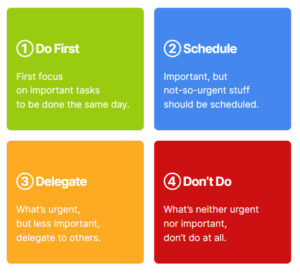
With inboxes overflowing with emails, the weight of deadlines and never-ending demands of work and home responsibilities, it’s easy to find ourselves in a perpetual state of rushing. As you’re reading this, you might already be mentally juggling your next task or even feeling guilty for taking a moment away from your endless to-do list. If this sounds familiar, you’re likely caught in the whirlwind of busyness that consumes so many of us today.
According to Pew Research Center, 52 per cent of people try to multitask, while 60 per cent feel too busy to truly enjoy life. Yet, being busy doesn’t necessarily mean being productive. It often leads to a cycle of feeling overwhelmed and accomplishing little in the grand scheme of things. Productivity, on the other hand, is about using time efficiently to achieve more in less time and learning how to prioritize and negotiate tasks.
The antidote to this frantic pace of life involves doing less and understanding why we find ourselves short on time despite our endless efforts. It’s also about managing our time in order to protect our mental and physical well-being. So, how can we reclaim our time in a world that never seems to slow down and focus on what truly matters?
“Never mistake motion for action.” – Ernest Hemingway
Beware a Culture of Busyness
Our brains aren’t wired to handle constant urgency. When subjected to constant stress and overload, our primal fight-or-flight response kicks into gear, inundating our bodies with a surge of cortisol and adrenaline. This physiological reaction can serve us well in moments of danger, but its prolonged activation can wreak havoc on our well-being. Chronic stress can lead to burnout and chip away at our cognitive faculties, undermining our physical health.
As we work with computers, smartphones and other gadgets, multi-tasking is often celebrated as a symbol of efficiency. However, research reveals a stark truth: our brains thrive when focused on one task at a time. The reality is that multitasking can hamper productivity by as much as 40 per cent. More hours worked doesn’t necessarily mean that we get more things done. Instead, it can lead to more stress and exhaustion.
Studies highlight the detrimental effects of attempting to juggle multiple tasks simultaneously, urging us to prioritize depth over breadth. Findings from institutions like the University of Pennsylvania and UCLA calculated the optimal allocation of free time for our well-being. The magic number hovers around 9.5 discretionary hours per working day, a figure that eludes many of us trapped in the relentless cycle of work and domestic responsibilities.
In spite of these startling statistics, busyness is becoming a status symbol. We often come across social media posts by celebrities showcasing their packed schedules, hopping from one event or appearance to the next. These displays of busyness can convey a sense of importance to others. In a study, researchers found that individuals who opted for grocery delivery were perceived as busier and of higher social class. Similarly, a woman wearing a Bluetooth headset was associated with a higher status compared to another wearing headphones. When participants were presented with imaginary letters from a friend, one describing a “crazy busy” life and the other portraying a “relaxed” one, they tended to attribute greater wealth, skills and social status to the writer of the busy letter.
Suggested Video: Too Busy for Productivity
“Lost time is never found again.” – Benjamin Franklin
Strategies for Success
There’s no shortage of advice on how to be less busy and more productive. “Treat email like laundry” is just one piece of advice from Google’s productivity expert, Laura Mae Martin. In an interview with Harvard Business Review, she shared practical ways she helps her colleagues and company executives manage their time, calendars and inboxes. Martin says, just as we could carefully budget our money, we should be intentional about how to allocate our time.
Now that we recognize that productivity is not about busyness and more about making every moment count, here are some techniques to consider:
- Eisenhower Matrix:This time management framework is named after Dwight D. Eisenhower, the 34th U.S. President, who used this method to prioritize his workload. This method is designed to help prioritize tasks by categorizing them into four quadrants based on urgency and importance:

The four quadrants of the Eisenhower Matrix. [Source: eisenhower.me]
The matrix provides clarity on priorities, forcing you to be clear about your goals and what’s most important. However, this method doesn’t account for the complexity or resources required for each task, which can be important factors in prioritization. It also doesn’t consider that delegating tasks may not be possible for everyone. This method may work best if you have autonomy over your time and can adjust your priorities accordingly.
- Time Blocking:This time management technique involves dividing your day into specific blocks of time, each dedicated to accomplishing a particular set of tasks. Benjamin Franklin is one of the earliest known adopters of this method. Time chunking provides intentionality and focus, ensuring you dedicate specific time to your most important tasks and goals. It also allows you to proactively manage your schedule, even if you can’t control all of your work hours. This technique also requires discipline to stick to the plan. If you don’t protect your time blocks, it’s easy for them to get derailed by interruptions. It can also feel restrictive to have such a structured schedule and if you underestimate how long certain tasks will take, it can throw off your schedule.
- Pomodoro Technique:A variation of time blocking, the Pomodoro Technique divides work into manageable intervals of 25 minutes, interspersed with brief breaks. Here’s how it works: select a task, set a timer for 25 minutes, focus solely on the task until the timer signals the end, then indulge in a short break of up to five minutes. After completing four Pomodoro intervals, take a longer break. This technique improves focus because it breaks work into short, timed intervals, and reduces burnout by incorporating short breaks.
- Two-Minute Rule:This technique is designed to help us overcome procrastination by quickly completing small tasks. If a task requires less than two minutes of your time, the recommendation is to address it immediately rather than postponing it. The objective is to accumulate small victories, creating momentum to tackle larger tasks. This approach creates a sense of accomplishment and prevents minor tasks from accumulating. However, frequent transitions between tasks can potentially diminish overall productivity and inadvertently escalate into more complicated projects.
Each of these strategies and techniques carries its own set of advantages and drawbacks. It’s important to carefully consider and evaluate which one aligns best with your work hours, schedule and personal preferences. By selecting an approach that suits your needs, you can see tangible results and feel motivated to keep going.
“You don’t have to see the whole staircase, just take the first step.” – Martin Luther King Jr.
Learning to Say No
One of the most effective techniques for improving time management and productivity is easier said than done: learning to say no. Sometimes we feel guilty when turning down requests from people so we end up agreeing and accepting their requests even when we don’t want to.
A few ways to say no, according to one productivity expert, include:
- “Thanks for the opportunity, but I won’t be able to attend.”
- “I’ve gone to so many events in the past couple of weeks and am honestly pretty exhausted. But thanks for the invite, and good luck with your event!”
- “I won’t be able to attend on that specific day, but I’d be happy to connect you with my former colleague, Sandra, who might be a good fit.”
- “I wish I could make it, but I’ll be out of town. Please let me know the date of your next event so I can block it in my calendar.”
Saying no allows you to set clear boundaries for yourself about what tasks align with your goals and values, giving you control over your time and preventing you from sacrificing it on activities that don’t fulfill you.
Suggested Video: The Unexpected Key to Boosting Your Productivity
“Don’t confuse activity with productivity. Many people are simply busy being busy.” – Robin Sharma
Work Smart, Not Hard
Productivity is about working smarter. By implementing an effective strategy suited to your needs, you can be more efficient, achieve your goals and carve out more time for the things that really matter. Shift your focus from staying busy to making meaningful progress, one step at a time.
Other Relevant Videos:
The Art of Stress-Free Productivity
“You can do anything, but not everything.” – David Allen



